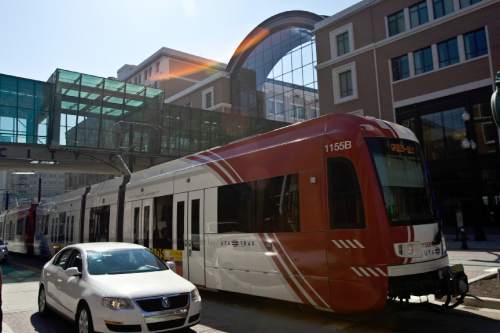This is an archived article that was published on sltrib.com in 2015, and information in the article may be outdated. It is provided only for personal research purposes and may not be reprinted.
The Utah Transit Authority says its August expansion of weekend bus and train service — plus more frequent weekday service on some key routes — quickly proved to be popular.
Sunday ridership quadrupled on the bus routes where it was added or expanded — from 354 riders previously to 1,461 each Sunday.
UTA officials said Tuesday that such increases may give voters a reason to support Proposition 1, which would raise sales taxes for transportation by a penny for every $4 spent.
"The amount of service will just really expand," if Prop 1 passes, said UTA Board member Robert McKinley.
UTA is officially neutral on Prop 1, and says it cannot campaign for it — but it does offer information about how it might spend extra money and how it would affect ridership. It figures Prop 1 could increase its revenues by 13 percent, or $39 million annually.
In August, UTA increased its overall service by about 3 percent in both hours and mileage, said Christopher Chestnut, senior manager of integrated-service planning. It was funded by higher-than-expected sales tax revenue this year, and by savings in operations, including lower-than-expected fuel costs.
Most service increases came on weekends. Bus service on Sundays increased by 31 percent in miles and 36 percent in hours. Train service, mostly for TRAX, increased 22 percent in miles and 28 percent in hours.
On Saturdays, bus service was up 12 percent in both miles and hours. Rail service was increased by 4 percent in miles and 9 percent in hours. Weekday frequency was also up on some key bus routes.
Chestnut outlined the ridership gains those changes brought to affected routes between Aug. 17 and Sept. 30 for the UTA Board. They include:
• Sundays: Besides the 313 percent increase in bus ridership on affected routes, rail ridership increased by 14 percent — from 16,805 riders per Sunday to 19,210.
• Saturdays: Bus routes with changes saw ridership increase by 23 percent. Rail ridership increased 6 percent.
• Weekdays: Bus ridership increased 13 percent on affected routes, while rail ridership increased 11 percent.
If Proposition 1 passes, UTA estimates that its plans will increase transit ridership by 15 percent, remove 2.3 million car trips from the road each year, and improve service to 60 percent of minorities, low-income and no-car households.
Details of its rideuta.com/mc/?page=UTA-Home-serviceimprovements">proposals are available online at rideuta.com.
In counties where UTA operates, 40 percent of money from Prop 1 would go to the transit agency, and 60 percent would go to cities and counties for roads and other local transportation needs.
Proponents of Prop 1 tend to stress how it will fund roads, while critics point to how much money will go to the sometimes-controversial UTA.
For example, a voter information pamphlet in Utah County contains a written statement by Commissioner Bill Lee, Mapleton Mayor Brian Wall, state Sens. Margaret Dayton and Mark Madsen and Rep. Brian Greene saying Prop 1 should be rejected because of UTA's "egregious misuse of tax dollars" and its "lack of transparency."



